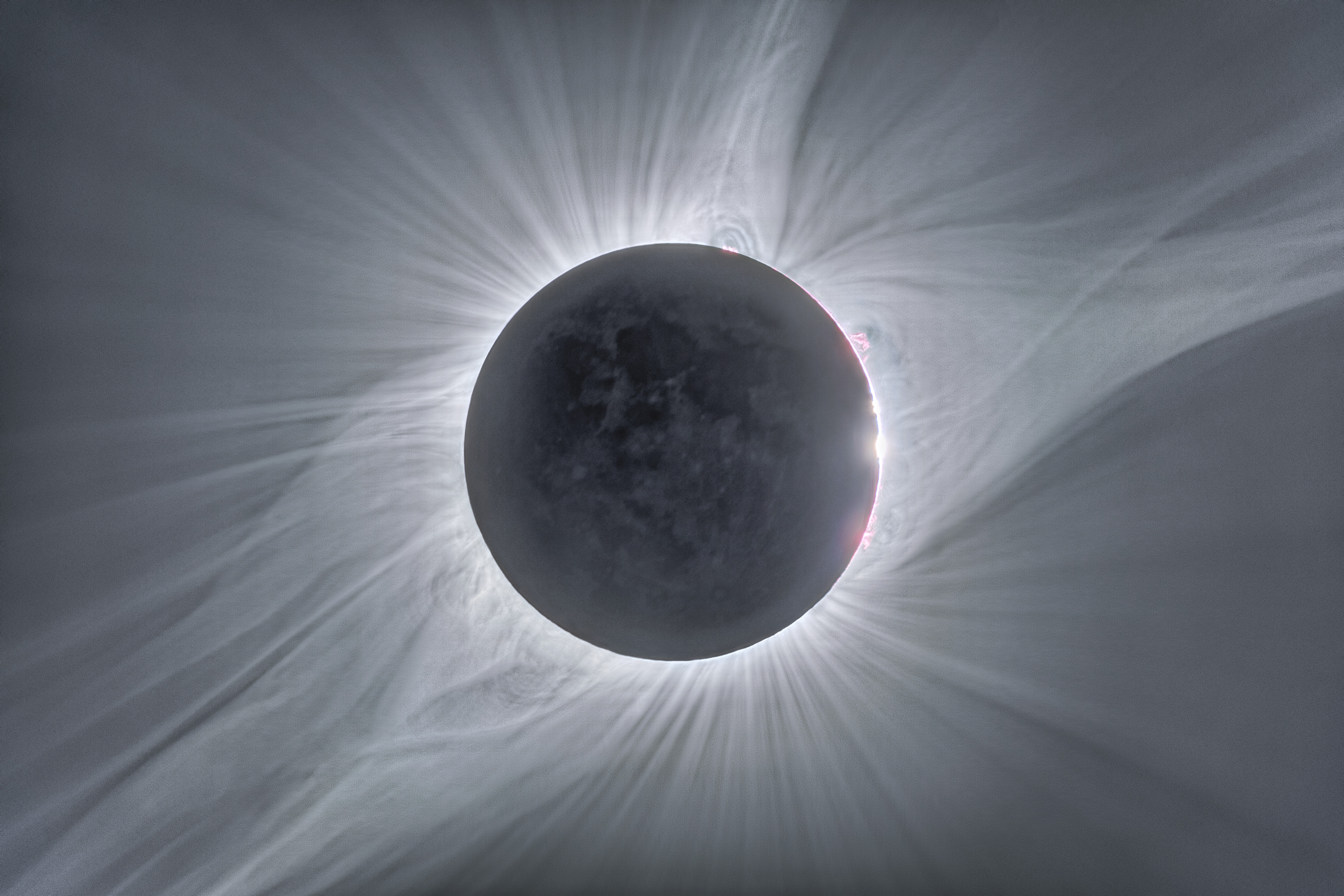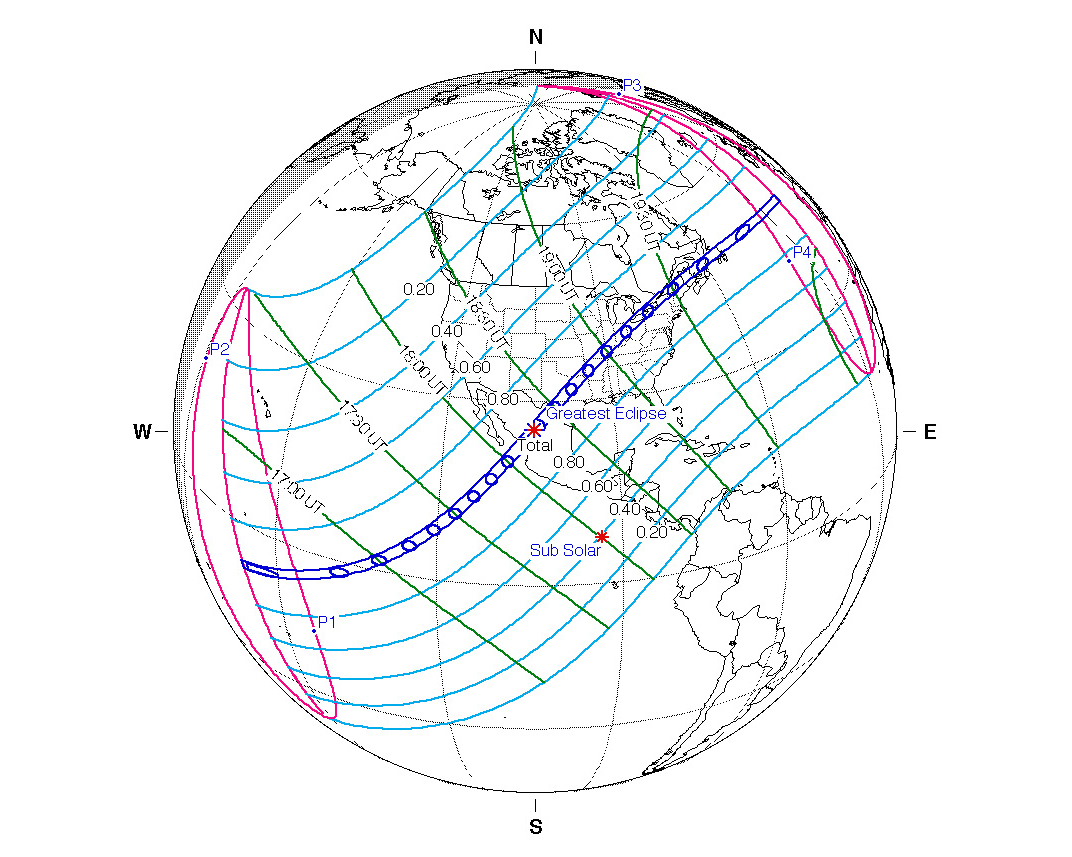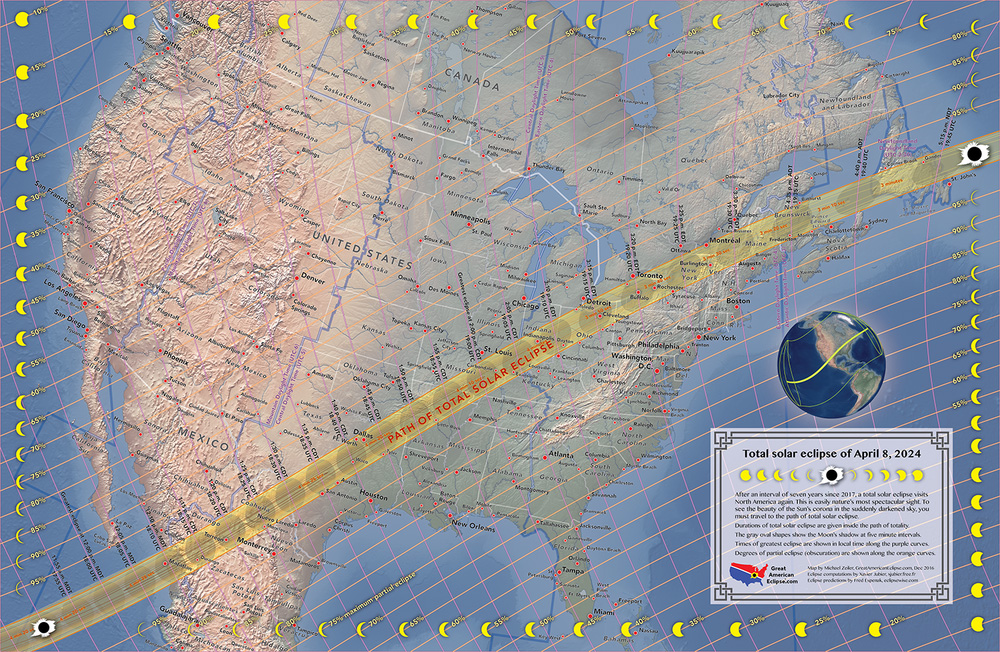The next Great North American Solar Eclipse is coming.
Four years from now, on Monday, April 8, 2024, a total eclipse of the sun will sweep across our continent. The dark shadow cone of the moon — known as the umbra — will trace out a path like a black crayon across parts of 15 states. An estimated 130 million people will either be positioned inside or within less than a day's drive of the zone of the total eclipse. Almost all of North America, as well as Central America and a sliver of northwestern South America will see a partial eclipse.
The path of totality will begin in the Pacific Ocean at a point 7 degrees south of the equator at longitude 158 degrees and 44 minutes west.. The moon's dark umbral shadow — from where the glorious spectacle of a total solar eclipse can be viewed — will then move northeast across the Mexican states of Sinaloa, Nayarit, Durango and Coahuila, then cross over the Rio Grande River into the Lone Star State of Texas. The American portion of the totality track, averaging 114 miles (184 kilometers) in width, will stretch from southwest Texas to northern Maine.
Video: Total Solar Eclipse in April 2024 - See the path of totality
Related: Total solar eclipse 2024: Here's what you need to know

While passing through Ohio, upstate New York and northern New England, the dark lunar shadow will also interact with the Canadian provinces of Ontario, Quebec and New Brunswick.
After that, totality will be observable from parts of Prince Edward Island, Nova Scotia and the island of Newfoundland. In all, the umbra will touch the Earth for 3 hours and 14 minutes.
Here is a closer look at how the totality track will sweep across Mexico, United States and Canada.
Get the Space.com Newsletter
Breaking space news, the latest updates on rocket launches, skywatching events and more!

Mexico
The moon's umbra first meets land at the Pacific coast of Sinaloa, approximately 400 miles (640 km) northwest of Guadalajara. The city of Mazatlán (population: 438,000) will see the sun go dark at 18:07 UT with totality lasting 4 minutes 17 seconds.
The most favorable land area for observing is in the state of Durango, 5 miles (9 km) north-northwest of the city of Nazas (population: 3,600), where the centerline duration is 4 minutes 28 seconds with the sun at mid-eclipse (1:17 p.m. local time; 1817 GMT) 70 degrees above the horizon. Nowhere else will the eclipsed sun appear higher, or totality last longer. These factors will almost certainly attract many amateur and professional astronomers as well as tour operators to Mexico, where the prospects for good weather are very encouraging. Indeed, Nazas is already being dubbed as "Eclipse City," and its close proximity to the point of greatest eclipse is mentioned on its Wikipedia page.
United States

For the second time in less than 7 years, a total eclipse of the sun will sweep across the contiguous (48) United States. But compared to the "Great American Total Eclipse" of Aug. 21, 2017, the 2024 eclipse is far superior in that the path of totality is roughly 40% wider and the duration of totality along the centerline of the eclipse path lasts anywhere from 42 to 107 seconds longer than the maximum duration of the 2017 eclipse!
The first sizable U.S. population center that will greet the total eclipse will be Elm Creek in Maverick County, Texas (population: 2,500), which will see the sun go dark at 1:27 p.m. CDT (18:27 UT). Totality will last 4 minutes 25 seconds, with the sun standing 69 degrees high in the southern sky.
One impressive fact about the American portion of the eclipse track are the number of metropolitan areas with populations of over one million people that are in the eclipse path. These include Dallas-Fort Worth (6.8 million; most populous anywhere within the path), Austin (2.2 million), Cleveland (2.1 million), Indianapolis (2 million), Buffalo (1.1 million) and Rochester (1 million). And there are three additional metro areas of over 2 million people whose northwest portions straddle the southern edge of the totality path: San Antonio (2.5 million), Cincinnati and Columbus (each with 2.1 million).
And here's something that will make fans of Max Klinger (of M*A*S*H TV fame) happy: Toledo, Ohio will experience 1 minute 50 seconds of total eclipse beginning at 3:12 p.m. EDT (19:12 UT).
Cities just outside of the totality path where the moon will cover a significant percentage of the sun's disk in an exceedingly large partial eclipse include: Pittsburgh (97.4%), Memphis (97.8%), St. Louis (99.1%), Louisville (99.2%) and Detroit (99.4%). In the most extreme case, totality is no more than a few hours' drive away.
The shadow will exit the U.S. at Aroostook County in Maine, where in between the communities of Monticello and Littleton, totality arrives at 3:22 p.m. EDT (1932 GMT) and will last a very respectable 3 minutes 22 seconds with the sun 35 degrees high in the western sky.
Defying the law of averages
Interestingly, for a specific geographic location on the Earth's surface, a total eclipse of the sun occurs (on average) once every 375 years. However, the paths of the 2017 and 2024 eclipses crisscross in America's heartland. Both eclipse paths overlap over a region encompassing parts of three states: Illinois, Missouri and Kentucky. The zone of overlapping totality measures almost 9,000 square miles (23,000 square km), or roughly the size of New Jersey.
For both eclipses, their respective centerlines cross near the eastern shore of Cedar Lake in Jackson County, Illinois. Technically, the closest town to this exact spot is Makanda, Illinois (population: 600). The nearest city of any size is Carbondale, Illinois (population: 26,000) located about three miles to the northeast. In fact, both Makanda and Carbondale are touting themselves as the place where the two centerlines cross, with Carbondale and its Southern Illinois University partner adopting the tagline "Eclipse Crossroads of America."
An even more amazing coincidence will take place about 10 miles north of the Texas community of Utopia (population: 230), at latitude 29 degrees and 46 minutes north, longitude 99 degrees and 30 minutes west. The centerline of the 2024 eclipse path passes through here, but on Oct. 14, 2023, the centerline of an annular solar eclipse will cross here as well. An annular eclipse differs from a total one in that the moon is too far away to cover the sun completely; at maximum eclipse a thin ring of sunlight shines all around the dark silhouette of the moon. So those living in this part of central Texas will be able to witness a spectacular "ring" eclipse, followed less than six months later by the even more spectacular sight of a total eclipse!
Canada
As the moon's umbra is sliding across parts of northern Ohio, a southeast sliver of the lower peninsula of Michigan, northwestern Pennsylvania and upstate New York, the northern half of the umbra will be moving across southeast Ontario. Point Pelee, the southernmost tip of Canada, witnesses 2 minutes 55 seconds of totality beginning at 3:13 p.m. EDT (1913 GMT).
The 5.9 million people who reside in the Greater Toronto Metro area will see the sun narrowed down to a mere spot of light as all but one-tenth of a percent of its disk will be covered at 3:20 p.m. EDT (1920 GMT). But across Lake Ontario, 35 miles (55 km) to the southwest, the city of Hamilton (population: 763,000) will be rewarded with 1 minute 43 seconds of daytime darkness at 3:18 p.m. EDT (1918 GMT).
The shadow then moves into Quebec province; at 3:26 p.m. EDT (1926 GMT) its northern edge will cut the metropolitan area of Montreal (population: 4.1 million) virtually in half. South of a line running from Vandreuil-Dorion to Boucherville will see a total eclipse, while north of that line will see a partial eclipse. Farther to the northeast, Quebec City sees a very large (98.7%) partial eclipse at 3:30 p.m. EDT (1930 GMT).
The total eclipse then visits the maritime provinces of New Brunswick, Prince Edward Island and clips the northernmost end of Cape Breton Island of Nova Scotia. The shadow finally bids North America a fond adieu as it slips off the Bonavista Peninsula on the Island of Newfoundland and out into the open waters of the Atlantic at 4:16 p.m. NDT (1946 GMT).
Eight minutes later, the umbra will slide off the Earth at local sunset, approximately 1,250 miles (2,000 km) west of France, putting an end to our Great North American Solar Eclipse.
Mark your calendars!
- Total solar eclipse of 2024: Here are maps of the 'path of totality'
- Get ready for 2 solar eclipses coming to the US in 2023 and 2024
- How to catch the next eclipse: A list of solar and lunar eclipses in 2020 and beyond
Joe Rao serves as an instructor and guest lecturer at New York's Hayden Planetarium. He writes about astronomy for Natural History magazine, the Farmers' Almanac and other publications. Follow us on Twitter @Spacedotcom and on Facebook
OFFER: Save 45% on 'All About Space' 'How it Works' and 'All About History'!
For a limited time, you can take out a digital subscription to any of our best-selling science magazines for just $2.38 per month, or 45% off the standard price for the first three months.
Join our Space Forums to keep talking space on the latest missions, night sky and more! And if you have a news tip, correction or comment, let us know at: community@space.com.

Joe Rao is Space.com's skywatching columnist, as well as a veteran meteorologist and eclipse chaser who also serves as an instructor and guest lecturer at New York's Hayden Planetarium. He writes about astronomy for Natural History magazine, Sky & Telescope and other publications. Joe is an 8-time Emmy-nominated meteorologist who served the Putnam Valley region of New York for over 21 years. You can find him on Twitter and YouTube tracking lunar and solar eclipses, meteor showers and more. To find out Joe's latest project, visit him on Twitter.
-
wilsonpossible ReplyAdmin said:The Great North American Solar Eclipse is coming.
We're T-minus 4 years to the next Great American Solar Eclipse in 2024 : Read more
I planned my last eclipse for 20 years... this one is going to be a lot harder, and it's not really talked about. Spring is a horrible time for an ecilpse in the US. Most places are partly to mostly cloudy through May.
I looked up average cloud cover on each day, and it was pretty high from the midwest down to texas, and even into mexico.
Anywhere you go may have to be planned at the last minute. -
Lord Hung Reply
I am going to try to get a room at Niagra Falls, it's risky to anchor there but my God what a sight it will be!wilsonpossible said:I planned my last eclipse for 20 years... this one is going to be a lot harder, and it's not really talked about. Spring is a horrible time for an ecilpse in the US. Most places are partly to mostly cloudy through May.
I looked up average cloud cover on each day, and it was pretty high from the midwest down to texas, and even into mexico.
Anywhere you go may have to be planned at the last minute.
Did you do the last one? I live in Columbus, OH and we went down to KY about an hour from Memphis, not one cloud in the sky! Incredible!
Unfortunately for 2 and a half minutes of incredible it took 9 hours just to get out of KY...

